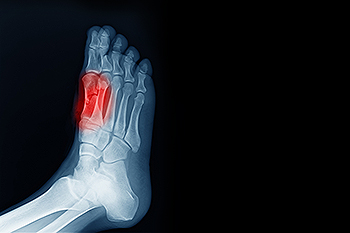Connect With Us
Blog
Items filtered by date: July 2022
Individuals at Risk of Experiencing Stress Fractures

Stress fractures can occur in the metatarsal bones of the foot when these bones undergo persistent stress, pressure, or trauma. As a result of the stress fracture, patients may experience heightened levels of pain. The condition may take anywhere from four to twelve weeks to fully heal after being treated. For treatment, some patients may have to wear special footwear or casts underneath the knee. There are several different groups of people that are more likely to experience a stress fracture. For example, women are more prone to developing stress fractures. Additionally, individuals that spend a significant part of the work day completing physical activities on their feet are prone to stress fractures. This group of people includes dancers, food servers, and hair stylists. Lastly, people with underlying bone conditions such as osteoporosis might be more susceptible to this condition because their bones are thinner and weaker. If you fall into one of these categories, then you should be especially mindful of the risk of developing stress fractures. Contact a podiatrist for more information.
Activities where too much pressure is put on the feet can cause stress fractures. To learn more, contact David A. Edmonds, DPM from Advanced Podiatry Associates. Our doctor can provide the care you need to keep your pain free and on your feet.
Dealing with Stress Fractures of the Foot and Ankle
Stress fractures occur in the foot and ankle when muscles in these areas weaken from too much or too little use. The feet and ankles then lose support when walking or running from the impact of the ground. Since there is no protection, the bones receive the full impact of each step. Stress on the feet can cause cracks to form in the bones, thus creating stress fractures.
What Are Stress Fractures?
Stress fractures occur frequently in individuals whose daily activities cause great impact on the feet and ankles. Stress factors are most common among:
- Runners
- People affected with Osteoporosis
- Tennis or basketball players
- Gymnasts
- High impact workouts
Symptoms
Pain from the fractures occur in the area of the fractures and can be constant or intermittent. It will often cause sharp or dull pain with swelling and tenderness. Engaging in any kind of activity which involves high impact will aggravate pain.
If you have any questions please feel free to contact our offices located in Northampton and Allentown, PA . We offer the newest diagnostic and treatment technologies for all your foot and ankle needs.
Tips for Managing Arthritis in the Feet

If you suffer from arthritis, you should know that you might be at an especially high risk of experiencing complications in your feet. For example, you may experience swelling and redness in the joints of your feet or you may even have severe pain when moving your feet. There are several things you can do by yourself at home to help manage the effects of arthritis and your feet. First, to treat swelling, you might consider applying an ice pack to the affected area of the feet. You might apply the ice for ten minutes, always being sure to use a towel to separate the pack from making direct contact with the skin. If your arthritis is making you experience plantar fasciitis in your feet, you might also consider rolling your feet over a water bottle. To do this, get a cold water bottle and roll the bottom of each foot back and forth over the bottle while sitting down. If you have arthritis, it is important to contact a podiatrist who can help you manage your condition.
Arthritis can be a difficult condition to live with. If you are seeking treatment, contact David A. Edmonds, DPM from Advanced Podiatry Associates. Our doctor can provide the care you need to keep you pain-free and on your feet.
Arthritic Foot Care
Arthritis is a joint disorder that involves the inflammation of different joints in your body, such as those in your feet. Arthritis is often caused by a degenerative joint disease and causes mild to severe pain in all affected areas. In addition to this, swelling and stiffness in the affected joints can also be a common symptom of arthritis.
In many cases, wearing ill-fitting shoes can worsen the effects and pain of arthritis. Wearing shoes that have a lower heel and extra room can help your feet feel more comfortable. In cases of rheumatoid arthritis, the arch in your foot may become problematic. Buying shoes with proper arch support that contour to your feet can help immensely.
Alleviating Arthritic Pain
- Exercises that stretch the foot can prevent further pain and injury and increase mobility
- Most of the pain can be alleviated with anti-inflammatory drugs, heat, and topical medications
- Massages can help temporarily alleviate pain.
It is best to see your doctor for the treatment that is right for your needs and symptoms. Conditions vary, and a podiatrist can help you determine the right method of care for your feet.
If you have any questions, please feel free to contact our offices located in Northampton and Allentown, PA . We offer the newest diagnostic tools and technology to treat your foot and ankle needs.
All About Sesamoiditis

Sesamoiditis is an inflammation of two tiny bones under the big toe and the tendons they are wrapped in. Sesamoids help support your weight as it transfers to the ball of the foot when you run, dance and walk in high heels. These bones are embedded in tendons, and when they become irritated from overuse they cause inflammation, or tendonitis. Symptoms of sesamoiditis include pain under the big toe, difficulty bending the big toe, swelling, redness and sometimes bruising. Just walking can be painful. People with high arches or flat feet, who roll their foot inward when they walk, or who have gout are at risk for sesamoiditis. A podiatrist can examine your feet and test for mobility, as well as to rule out other causes of your condition, such as bone fracture or turf toe. Treatment may include steroid injections or, in chronic cases, surgery. Please consult a podiatrist for further information.
Sesamoiditis is an unpleasant foot condition characterized by pain in the balls of the feet. If you think you’re struggling with sesamoiditis, contact David A. Edmonds, DPM of Advanced Podiatry Associates. Our doctor will treat your condition thoroughly and effectively.
Sesamoiditis
Sesamoiditis is a condition of the foot that affects the ball of the foot. It is more common in younger people than it is in older people. It can also occur with people who have begun a new exercise program, since their bodies are adjusting to the new physical regimen. Pain may also be caused by the inflammation of tendons surrounding the bones. It is important to seek treatment in its early stages because if you ignore the pain, this condition can lead to more serious problems such as severe irritation and bone fractures.
Causes of Sesamoiditis
- Sudden increase in activity
- Increase in physically strenuous movement without a proper warm up or build up
- Foot structure: those who have smaller, bonier feet or those with a high arch may be more susceptible
Treatment for sesamoiditis is non-invasive and simple. Doctors may recommend a strict rest period where the patient forgoes most physical activity. This will help give the patient time to heal their feet through limited activity. For serious cases, it is best to speak with your doctor to determine a treatment option that will help your specific needs.
If you have any questions please feel free to contact our offices located in Northampton and Allentown, PA . We offer the newest diagnostic and treatment technologies for all your foot and ankle needs.
Recovery From Bunion Surgery

Patients who have had bunion surgery often find it takes approximately three to six weeks for a complete recovery. The side effects are generally minimal, and the bunion is gone permanently. Typical bunion surgery is often done as an outpatient and takes approximately one hour. Special shoes that minimize the pressure on the wound are often worn after surgery. It is beneficial to keep the foot elevated as often as possible during the first six weeks of recovery as this may help to reduce swelling. Additionally, it can help to allow excess fluid to drain away. It is important to keep walking to a minimum, especially during the early stages of recovery. Some patients find it helpful to use crutches as they keep the affected foot off the ground. The wound from the surgery will heal properly when the dressings are kept in place for a few weeks and remain dry. This enables the toes to heal in the proper position. Bunion surgery is an effective treatment for permanent removal, and it is suggested that you consult with a podiatrist who can determine if this is correct for you.
Foot surgery is sometimes necessary to treat a foot ailment. To learn more, contact David A. Edmonds, DPM of Advanced Podiatry Associates. Our doctor will assist you with all of your foot and ankle needs.
When Is Surgery Necessary?
Foot and ankle surgery is generally reserved for cases in which less invasive, conservative procedures have failed to alleviate the problem. Some of the cases in which surgery may be necessary include:
- Removing foot deformities like bunions and bone spurs
- Severe arthritis that has caused bone issues
- Cosmetic reconstruction
What Types of Surgery Are There?
The type of surgery you receive will depend on the nature of the problem you have. Some of the possible surgeries include:
- Bunionectomy for painful bunions
- Surgical fusion for realignment of bones
- Neuropathy decompression surgery to treat nerve damage
Benefits of Surgery
Although surgery is usually a last resort, it can provide more complete pain relief compared to non-surgical methods and may allow you to finally resume full activity.
Surgical techniques have also become increasingly sophisticated. Techniques like endoscopic surgery allow for smaller incisions and faster recovery times.
If you have any questions please feel free to contact our offices located in Northampton and Allentown, PA . We offer the newest diagnostic and treatment technologies for all your foot and ankle needs.

